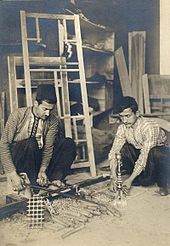
Smoking in Syria is steadily increasing in popularity amongst the Syrian population, mainly in the forms of cigarettes or narghiles. In Syria, the General Organization of Tobacco manages the growth and exportation of tobacco products. Syrians collectively spend about $600 million per year on tobacco consumption.[1] As of 2010, 20% of women and 60% of men smoke and 98% of the overall population is affected by passive smoking. Narghiles (also known as the hookah or water pipe) and cigarettes are the two main forms of tobacco consumption.[2] Despite the assumption that smoking, specifically the narghile, is embedded in Syrian culture, this phenomenon has only recently become widespread. Health officials are currently working on smoking cessation programs and policies, to remove this idea that smoking in Syria is an essential part of the culture, to educate regarding health effects, and to prevent citizens from smoking in public places.
- ^ Mabardi, Roueida (29 April 2010). "Smoking Ban Leaves Cafes Empty and Waterpipes Abandoned". The Daily Star: Lebanon. Retrieved 2 May 2012.
- ^ "Smoking Ban Burns Syrian Businesses". Al Jazeera. Archived from the original on 15 December 2021. Retrieved 2 May 2012.